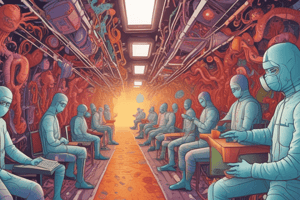Podcast
Questions and Answers
What is unique about the nucleic acid found in viruses?
What is unique about the nucleic acid found in viruses?
- It is always found in a double helix structure
- It is always double-stranded
- It is capable of replicating itself independently
- It can be either RNA or DNA, but never both (correct)
What is the primary reason why viruses cannot grow on artificial cell-free medium?
What is the primary reason why viruses cannot grow on artificial cell-free medium?
- They are totally dependent on living cells for existence (correct)
- They lack the necessary nutrients
- They are too small to be cultured
- They do not have the necessary enzymes for metabolism
What is the function of the receptor binding protein in viruses?
What is the function of the receptor binding protein in viruses?
- To translate viral proteins
- To attach or dock to cells (correct)
- To synthesise viral lipids
- To replicate the viral genome
What is present in the structure of a virus?
What is present in the structure of a virus?
Why are viruses not susceptible to antibacterial antibiotics?
Why are viruses not susceptible to antibacterial antibiotics?
Flashcards are hidden until you start studying
Study Notes
Characteristics of Viruses
- Viruses have a single type of nucleic acid, which can be either RNA or DNA, but not both.
- They have a protein coat that surrounds the nucleic acid, known as a capsid.
- Viruses are extremely small, ranging in size from 20-150 nanometers (nm).
- They can only multiply inside living cells, using the host cell's synthetic machinery.
- Viruses are totally dependent on living cells for their existence and cannot survive on their own.
Reproduction and Growth
- Viruses have a receptor binding protein that allows them to attach to and dock onto host cells.
- They cannot grow or reproduce in artificial, cell-free mediums.
Cellular Organization and Structure
- Viruses lack proper cellular organization and do not have cellular organelles.
- They lack a cell wall and cell membrane.
- Viruses are not susceptible to antibacterial antibiotics.
Structure of a Virus
Components
- Nucleic acid (either RNA or DNA)
- Capsid (protein coat)
- Envelope (optional)
- Surface proteins
- Lipids (found in the envelope)
Studying That Suits You
Use AI to generate personalized quizzes and flashcards to suit your learning preferences.




